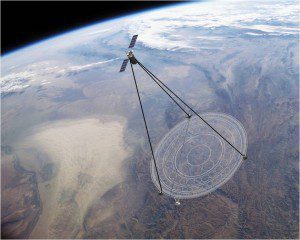Today, aircraft are used for some imagery requirements. Because of the huge quantity of aircraft needed, and because aircraft do not fly high enough to see into denied territories, spacecraft are also used for imagery requirements.
Spacecraft, however, face different challenges in providing persistent coverage. The size (aperture) of the optics needed, as well as the limitations of producing and launching extremely large precision glass optics, means it is infeasible to place such a system in geosynchronous earth orbit (GEO), approximately 36,000 kilometers high, where it could provide persistent coverage.
The Defense Advanced Research Projects Agency (DARPA) is exploring such a system: the membrane optical imager for real-time exploitation (MOIRE), a GEO-based system that uses a lightweight membrane optic etched with a diffractive pattern. The diffractive pattern is used to focus light on a sensor.
DARPA's MOIRE program seeks to enable the technologies required for large space platform optics. The program aims to demonstrate the manufacturability of large membranes (up to 20 meters), large structures to hold the optics flat, and the secondary optical elements needed to turn a diffraction-based optic into a wide bandwidth imaging device.
The MOIRE program began in March 2010 and encompasses multiple phases: Phase 1 (proof of concept), Phase 2 (system design) and an option for a Phase 3 (system demonstration). The program is currently in Phase 1.
Source: DARPA


